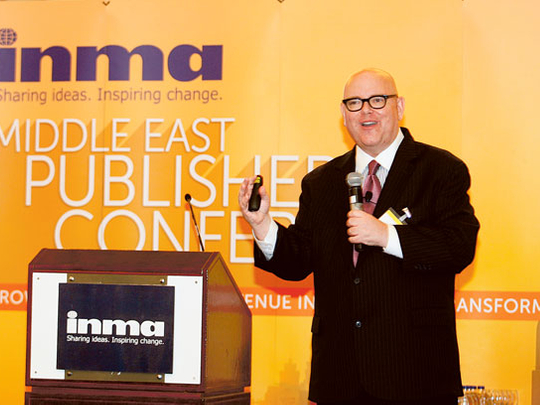
Dubai: Technology is fundamentally changing how people consume news, how journalism is produced and how advertising and marketing solutions are sold, said Earl J. Wilkinson, Executive Director and CEO, International News Media Association (INMA) in Dubai on Tuesday.
He said that publishers are already in the print-to-digital transformation and we all are in the moving in the “same direction as print revenues are heading southward.”
INMA has more than 7,000 members in more than 80 countries. The two-day Dubai conference is discussing ‘Growing Audience and Revenue in the Age of Transformation’.
“Members are rethinking their value propositions and are growing audience and revenue in new and different ways.
"But that does not mean print will die. Even in digitally disrupted places, print will survive for more than 100 years but the roles are going to be different,” he said.
“News brands [content creators] will be divided into different platforms like smartphones, tablets, etc. This is what media companies are going to see. For example, print in the morning; tablets and smartphones while commuting and desktop at work. Can we have a relation with the readers across all four platforms for 18 hours a day? It is really interesting to see,” he said.
The global data show the advertising will follow the “eyeballs” but it does not happen overnight.
“My advice is to embrace the change. The way we generate money is still ultimately the same. It is all about building audiences, quality of the audiences and engagement of the audiences, and the advertisement will follow. We are so afraid of change. Change is not bad and different is not bad, it is just different,” he said.
Yasmin Namini, Senior Vice-President and Chief Consumer Officer at New York Times, said that digital subscription initiatives are paying off.
“The transformation was not easy. We lost $100 million in revenues in 2011 in print advertising in one day,” she said.
She said that people are willing to pay for quality journalism.
“Our paid digital subscription stood at 875,000 compared to 1.1 million for print readership. Always consider print and digital business together.”
The US newspaper’s digital subscriber revenues in 2013 were $149.1 million. Revenues stood at $124.8 million from January to September 2014.
“We are moving from a print-centric workforce to a platform-agile workforce,” Wilkinson said.
Namini said that print is strong in this region compared to digital but how long will it continue is unknown. Nobody knows when the tsunami will hit, she said.
“More people are accessing New York Times website on mobile phones than desktops even though mobile does not monetise it. We are creating next-generation digital products and growing consumer revenue,” she said.









